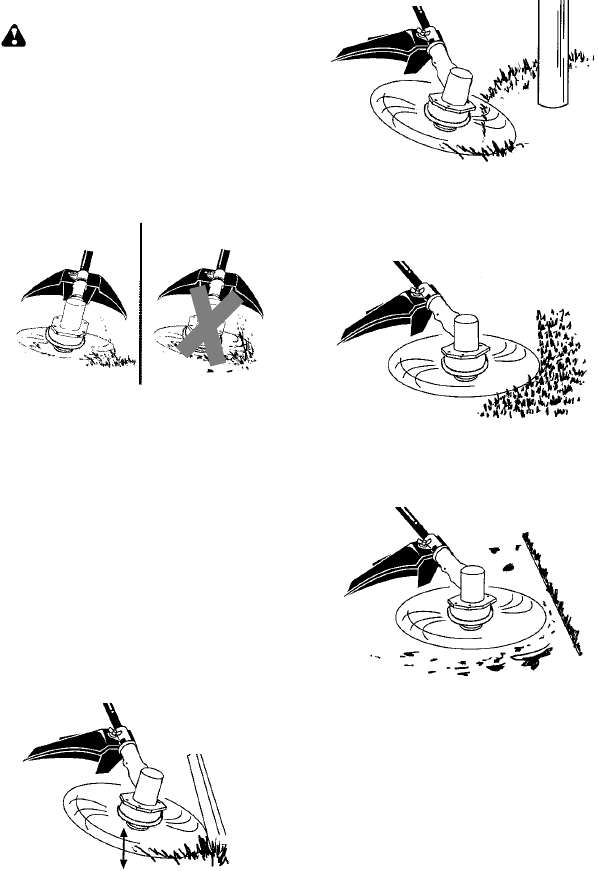
10
CUTTING METHODS
WARNING: Use minimum speed
and donotcrowdthe linewhen cuttingaround
hard objects (rock, gravel, fence posts, etc.),
whichcan damagethetrimmer head,become
entangled in the line, or be thrown causing a
serious hazard.
S The tip of the line does the cutting. You will
achieve the best performance and m ini-
mum line wear by not crowding the line into
the cutting area. The right and wrong ways
are shown below.
Tip of the line
does the cutting.
Right Wrong
Line crowded into
work area.
S The line will easily remove grass and
weeds fr omaroundwalls, fences, trees and
flower beds, but it also can cut the tender
bark of trees or shrubs and scar fences.
S For trimming or scalping, use less than full
throttle to increase line life and decrease
head wear, e specially:
S During light duty cutting.
S Near objects around which the line can
wrap such as small posts, trees or fence
wire.
S For mowingor sweeping, usefull t hrottlefor
a good clean job.
TRIMMING -- Hold the bottom of the trimmer
head about 3 inches (8 cm) above the ground
and a t an angle. Allow only the tip of t he l ine to
make contact. Do not force trimmer line into
work area.
Trimming
3 inches (8 cm)
above ground
SCALPING -- The scalping technique r emoves
unwanted vegetation down to t he ground. Hold
the bottom of the trimmer head about 3 in. (8
cm) above theground and at anangle. Allow t he
tip of the line to strike the ground around trees,
posts, monuments, etc. This technique in-
creases line wear.
Scalping
MOWING -- Your trimmer is ideal for mowing
in places conventional lawn mowers cannot
reach. In the mowing position, keep the line
parallel to the g round. Avoid pressing the
head into the ground as this can scalp the
ground and damage the tool.
Mowing
SWEEPING -- Thefanning action ofthe rotat-
inglinecanbeusedto blowaway loosedebris
from an area. Keep the line parallel to and
above the area surface and swing the tool
from side to side.
Sweeping
OPERAT ING INSTRUCTIONS FOR
USE WITH WEED BLADE
S Blade Thr us t is a reaction that only occurs
when using a bladed unit. This reaction can
cause serious injury such as amputation.
Carefully study this section. It is impo rtant that
you understand what causes blade thrust,
how you can reduce the chance of its
occurring, and how you can remain in control
of unit if blade thrust occurs.
S WHAT CAUSES BLADE THRUST -- Bla de
Thrust can occur when the spinning blade
contacts an object that it does not cut. This
contact causes the bladeto stop f or an i nstant
and then suddenly move o r “thrust” a way
from the object that was hit. The “thrusting”
reaction can be violent enough to cause the
operator to be propelled in any direction and
lose control of the unit. The uncontrolled unit
can cause serious injury if the b lade contacts
the operator or others.


















